QuestionNine mo old cocker spaniel experienced very sore foot - vet cleared out an absess. Has been on antibiotics and now getting another foot sore. Pad came off of a couple of his toes. Vet thinks its a skin infection. Xrays showed no lymphoma. Could this be a skin allergy? He has tiny scabs on his skin at base of fur in various places. Please give your opinion. He is currently on IV antibiotics at vet office - vet doesn't know what is causing. His while blood count was just slightly elevated. Painful for him to walk because of his sore feet. Please help with an opinion. Thanks very much.
AnswerI have taken a day to answer this because I was researching it.
This is a mystery but a couple of things pop up. One is Interdigital Furunculosis, which starts as an infection between the toes and progresses to nodules and blisters all over the toes.
The Merck Manual says this about it:
The most common cause is a deep bacterial infection. Many dog breeds (eg, Shar-Pei, Labrador Retriever, English Bulldog) are predisposed to bacterial interdigital furunculosis because of the short bristly hairs located on the webbing between the toes, prominent interdigital webbing, or both. The short shafts of hairs are easily forced backward into the hair follicles during locomotion (traumatic implantation). Hair, ie, keratin, is very inflammatory in the skin, and secondary bacterial infections are common. Less commonly, foreign material is traumatically embedded in the skin. Demodicosis ( Mange in Sheep and Goats) may be a primary cause of interdigital furunculosis. Canine atopy ( Allergic Inhalant Dermatitis: Introduction) is also a common cause of recurrent interdigital furunculosis.
Back to top
Clinical Findings and Lesions:
Early lesions of interdigital furunculosis may appear as focal or generalized areas of erythema and papules in the webbing of the feet that, if left untreated, rapidly develop into single or multiple nodules. The latter usually are 1-2 cm in diameter, reddish purple, shiny, and fluctuant; they may rupture when palpated and exude a bloody material. Interdigital furuncles are most commonly found on the dorsal aspect of the paw, but may also be found ventrally. Furuncles are usually painful, and the dog may be obviously lame on the affected foot (or feet) and lick and bite at the lesions. Lesions caused by a foreign body, eg, a grass awn, are usually solitary and often occur on a front foot; recurrence is not common in these cases. If bacteria cause the interdigital furunculosis, there may be several nodules with new lesions developing as others resolve. A common cause of recurrence is the granulomatous reaction to the presence of free keratin in the tissues.
Diagnosis:
This is often based on clinical signs alone. The major differential diagnoses are traumatic lesions and neoplasia, although the latter is rare. The most useful diagnostic tests include skin scrapings for Demodex mites, impression smears, or fine-needle aspirates to confirm the presence of an inflammatory infiltrate. Unusual or recurrent lesions should be excised for histopathologic examination. Solitary lesions may require surgical exploration to find and remove foreign bodies such as grass awns.
Treatment:
Interdigital furuncles respond best to a combination of topical and systemic therapy. Cephalexin (20 mg/kg, PO, tid, or 30 mg/kg, PO, bid) is recommended for 4-6 wk of initial therapy. However, because the lesions are pyogranulomatous, it may be difficult for antibiotics to penetrate them; therefore, >8 wk of systemic antibiotic therapy may be required for lesions to completely resolve. These lesions are often complicated by concurrent Malassezia spp infections. Oral ketoconazole or itraconazole (5-10 mg/kg) for 30 days may be indicated. The presence of Malassezia can be documented by cytologic examination of nail bed debris and/or impression smears of the skin. Topical foot soaks in warm water with or without an antibiotic solution (eg, chlorhexidine) and the application of mupiricin ointment are recommended. Some dogs may benefit from antibiotic wraps and bandaging. Antihistamines given for the first several weeks of treatment may partially alleviate pruritus, if present. Glucocorticoids are contraindicated.
Chronic, recurrent interdigital furunculosis is most often caused by inappropriate antibiotic therapy (too short, wrong dose/dosage, wrong drug), concurrent corticosteroid administration, demodicosis, an anatomic predisposition, or a foreign body reaction to keratin. Lesions that recur in spite of therapy can also be a sign of an underlying disease, eg, atopy, hypothyroidism, or concurrent Malassezia infection. Lesions in confined dogs are likely to recur unless the dog is removed from wire or concrete surfaces. In some chronic cases, surgical excision or surgical correction of the webbing via fusion podoplasty may be needed. Alternatively, pulse antibiotic therapy (full dosage therapy 2-3 times/wk) or chronic low dosage antibiotic therapy (eg, 500 mg/dog, PO, sid) may help maintain clinical remission and provide pain relief in dogs with chronic lesions. This therapy is recommended only when the inciting cause cannot be identified (eg, idiopathic pyoderma), treated (eg, anatomic predisposition), or resolved (eg, chronic infection caused by foreign body material or keratin).
Now I know this is a lot of medical speak but if you read it slowly you will get what most of it says.
While I can't find anything specific about losing pads it all seems to point to some type of infection or a sever allergy. In that respect you might be right. What kind of food are you feeding?
Some of these things are from caustic exposure, such as the dog gets on hot concrete or into something with lye in it.
If your vet isn't finding an answer then ask around at other vets if they have ever seen this condition.
Since I am not a vet this condition is not something I have seen even in the last 28 yrs of practice. I think this article is the closest thing to what your dog has and I would ask the treating vet about it.
Good luck and please let me know what you find out.

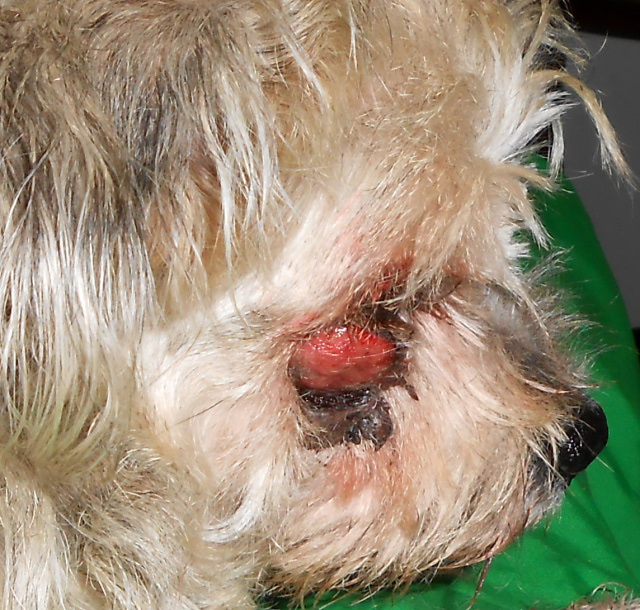 Cyst/Tumor on My Dogs Face
Question
Lilias Face
My dog Lilia is 11 years ol
Cyst/Tumor on My Dogs Face
Question
Lilias Face
My dog Lilia is 11 years ol
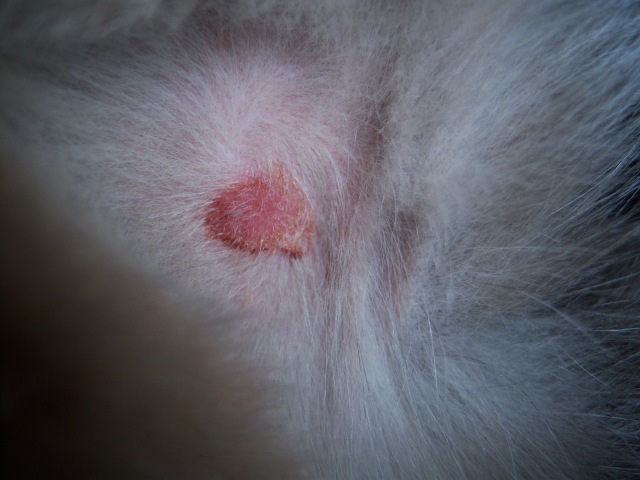 Skin (allergy) issues
Question
Licking sore
Tao my cat is about 9 years old,
Skin (allergy) issues
Question
Licking sore
Tao my cat is about 9 years old,
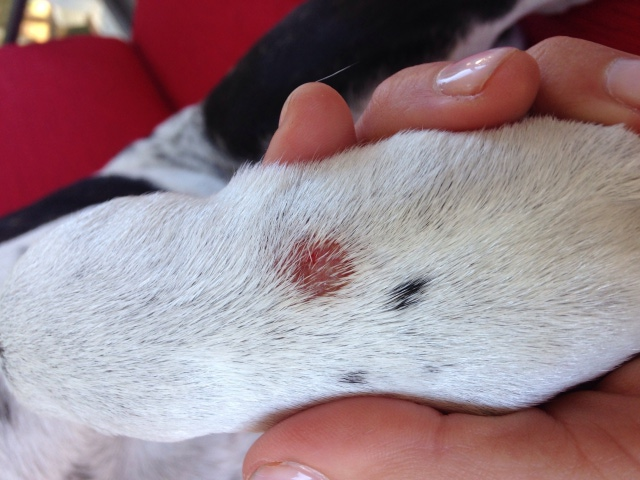 Where do I begin?!
QuestionGranuloma
Staph
QUESTION: Hello!
Where do I begin?!
QuestionGranuloma
Staph
QUESTION: Hello!
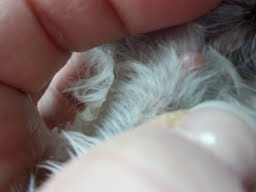 Small growth my dogs face
Question
growth photo 2 growth photo 3
Hi.
Small growth my dogs face
Question
growth photo 2 growth photo 3
Hi.
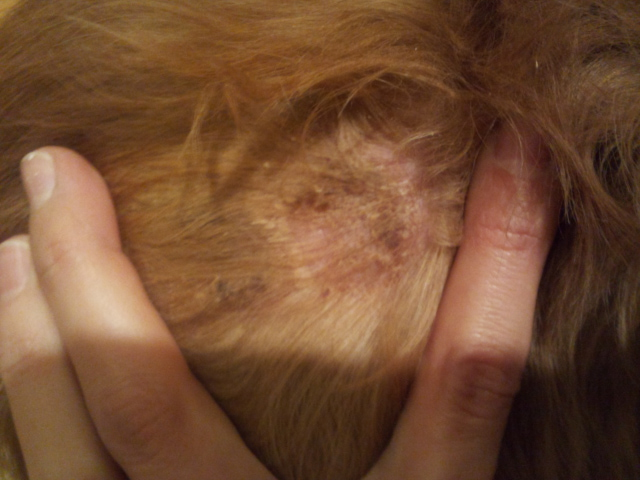 Sores on body
QuestionSore
QUESTION: Do you have any idea what
Sores on body
QuestionSore
QUESTION: Do you have any idea what